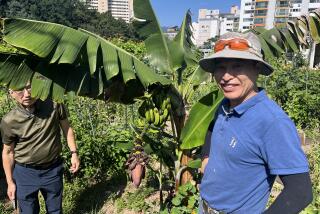Cloned trees raised in separate places react differently to drought
Nurture matters — in plants as well as people. Cloned trees raised in different places and environments react differently to drought conditions even though they’re genetically identical, scientists have found.
“Turns out the trees have a memory, and they are adapted to the environment in which they’re grown,” said Richard Meilan, a Purdue University molecular tree physiologist who was not involved in the study.
Researchers have long been interested in how much genes, versus environment, contribute to a creature’s biology and behavior; the many “twin studies” performed with humans attest to that fascination. Such studies have clearly shown that even genetically identical twins, though startlingly similar, bear distinct differences.
Plant growers had often noticed that a plant purchased from one nursery would be sickly while the same plant from another nursery, perhaps even cloned long ago from the same bush or tree, would flourish — a phenomenon referred to as the “nursery effect.”
To figure out what might be going on, Canadian researchers grew clones from poplar trees that were genetically identical but raised in different parts of Canada. They did this for three types of poplar varieties — Okanese, Walker and DN34. In each case, some variants came from Saskatchewan and the others from regions with different amounts of rainfall and sunlight.
Reporting July 11 in the Proceedings of the National Academy of Sciences, the researchers found that in the case of the Walker and DN34 clones, trees grown in different places reacted very differently when they were deprived of water.
Walker poplars raised in Alberta took two full days longer than their Saskatchewan siblings to respond to the simulated drought by closing up holes in their leaves, called stomata, to minimize water loss. And DN34 poplars raised in Manitoba closed their stomata two days sooner than DN34 poplars from Saskatchewan.
Okanese clones, however, took the same time to close up against the drought, regardless of where they were from.
The scientists also detected differences in gene activity that could be responsible for these differences, they said. The Okanese poplars’ gene patterns matched regardless of origin — but varied widely for Walker, and especially for DN34, poplars depending on where they’d been raised.
“We’re talking literally hundreds of genes doing something different in response [to drought], in plants from one location versus the other,” said study coauthor Malcolm Campbell, a genome biologist at the University of Toronto. “It’s really quite stunning.”
The oldest clone of the three, DN34, dates to the early 1900s — implying that differences strengthen with age. The youngest, Okanese, dates only to 1986 and showed no differences.
But Stephen DiFazio, a population geneticist at West Virginia University who was not involved in the study, said the researchers hadn’t entirely proved that the trees were 100% identical at the time of the experiment. Mutations could have accumulated over time, he suggested.







